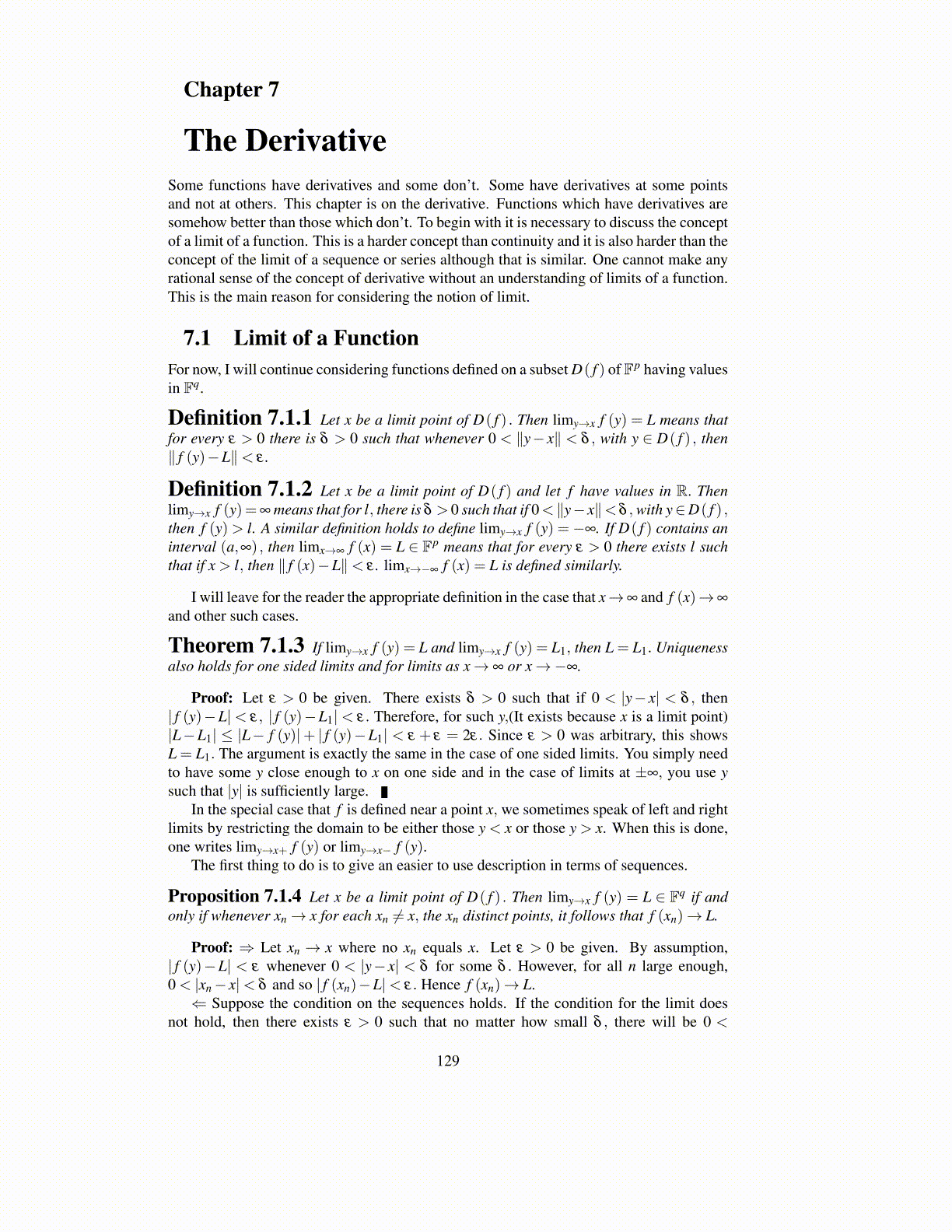
7.1. LIMIT OF A FUNCTION 129
Now let ε > 0 be given. There exists δ 1 such that if 0 < |x−a| < δ 1, | f (x)−L| < ε/2and there exists δ 2 such that if 0 < |x−a| < δ 2, then |g(x)−L| < ε/2. Letting 0 < δ ≤min(δ 1,δ 2), if 0 < |x−a|< δ , then
|h(x)−L| ≤ | f (x)−L|+ |g(x)−L|< ε/2+ ε/2 = ε.
Proposition 7.1.7 If x ∈ D( f ) and x is a limit point of D( f ) , then f is continuous at xif and only if limy→x f (y) = f (x).
Proof:⇒Let yn→ x where yn ∈ D( f ) and the yn are distinct. Then by continuity of fat x, it follows that limn→∞ f (yn) = f (x).⇐ Let ε > 0 be given. Then there is δ > 0 such that whenever 0 < ∥y− x∥< δ , it will
follow that ∥ f (y)− f (x)∥< ε . However, if y = x, then ∥ f (y)− f (x)∥= 0 < ε and so theconditions for continuity are satisfied.
The case of this proposition which is of the most interest here in this chapter is thefollowing theorem. Intervals are of the form (a,b) , [a,b),(a,b], or [a,b], Endpoints of aninterval are clearly limit points of the interval.
Theorem 7.1.8 For f : I→ R, and I is an interval. then f is continuous at x ∈ I ifand only if limy→x f (y) = f (x) .
Example 7.1.9 Find limx→3x2−9x−3 .
Note that x2−9x−3 = x+3 whenever x ̸= 3. Therefore, if 0 < |x−3|< ε,∣∣∣∣x2−9
x−3−6∣∣∣∣= |x+3−6|= |x−3|< ε.
It follows from the definition that this limit equals 6.You should be careful to note that in the definition of limit, the variable never equals
the thing it is getting close to. In this example, x is never equal to 3. This is very significantbecause, in interesting limits, the function whose limit is being taken will not be defined atthe point of interest. The habit students acquire of plugging in the point to take the limit isonly good on useless and uninteresting limits which are not good for anything other than togive a busy work exercise, deceiving people into thinking they know what is going on.
Example 7.1.10 Let
f (x) =x2−9x−3
if x ̸= 3.
How should f be defined at x = 3 so that the resulting function will be continuous there?
The limit of this function equals 6 because for x ̸= 3, x2−9x−3 = (x−3)(x+3)
x−3 = x+3. There-fore, by Theorem 7.1.8 it is necessary to define f (3)≡ 6.
Example 7.1.11 Find limx→∞x
1+x .
Write x1+x = 1
1+(1/x) . Now it seems clear that limx→∞ 1+(1/x) = 1 ̸= 0. Therefore,
Theorem 7.1.5 implies limx→∞x
1+x = limx→∞1
1+(1/x) =11 = 1.